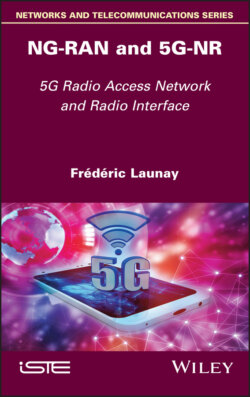Читать книгу NG-RAN and 5G-NR - Frédéric Launay - Страница 26
1.4. Scheduling and QoS 1.4.1. Scheduling
ОглавлениеScheduling enables us to share radio resources among all connected users. A scheduling task is performed in real time to share radio resources among all mobiles. Scheduling attribution is calculated based on:
1 – the quality of the radio link for each mobile;
2 – requirements in terms of the quality of service expected by each mobile;
3 – the state of the mobile buffer.
The scheduler is performed at the MAC layer of the NG-RAN node and defines the scheduling for downlink and uplink transmissions.
The quality of the radio link is used to define the modulation and coding scheme (MCS) for a given mobile, as well as the transmission power. The MCS is dynamically adjusted according to the HARQ (Hybrid Automatic Repeat Request) retransmission rate.
To meet mobile requirements, several strategies can be defined at the scheduler level:
1 – fairness, a strategy for which each mobile receives the same resource allocation regardless of the modulation scheme;
2 – proportional fairness which allocates more frequency resources for mobiles with less efficient MCS;
3 – round-robin, a strategy which consists of allocating equal resources to all mobiles;
4 – max-CQI, a strategy that aims to maximize cell capacity by prioritizing the allocation of radio resources to mobiles which have the best radio quality.
The scheduler is based on measurement reports:
1 – the state of the buffer BSR (Buffer Status Report);
2 – the quality of the radio link (CSI-RS);
3 – the rising power margin PHR (Power Headroom Reports);
4 – Inter-Cell Interference Coordination (ICIC) between NG-RAN nodes.
From this information, the scheduler defined:
1 – the frequency radio resources to be allocated for each mobile;
2 – the number of spatial layers that can be used, depending on the category of the mobile;
3 – the transmission TTI (Time Transmission Interval) instants.
The mobile listens to the information transmitted over the PDCCH (Physical Downlink Control Channel) logical control channel and decodes the information channel when it detects its radio identifier C-RNTI.
The scheduler makes its decisions at each slot. The duration of the TTI slot depends on the spacing between SCS (SubCarrier Spacing). While the scheduler decision is 1 ms in 4G, it is variable from 1 ms, 500 μs or 250 μs for 5G on the FR1 (Frequency Range 1) band, and can go down to 125 μs or 62.5 μs for the FR2 band.
Transmission on the downlink direction can be pre-empted for critical communication (low latency). The NG-RAN node informs the mobiles by transmitting the INT-RNTI identifier over the PDCCH control channel.
Semi-persistent scheduling allows us to periodically allocate radio resources for a mobile. The periodicity of the messages is transmitted over the RRC layer and the resource allocation is transmitted to the mobile via the CS-RNTI identifier.
